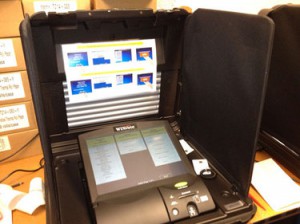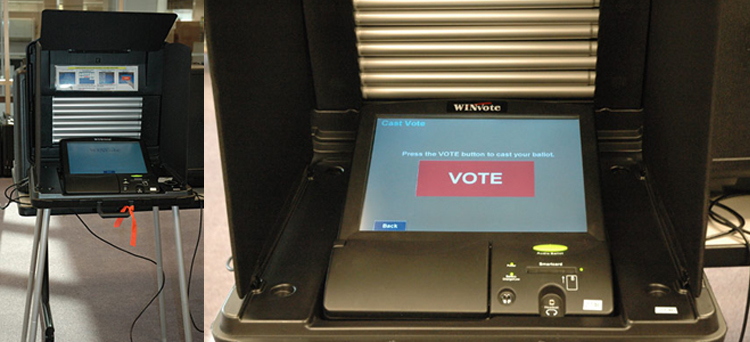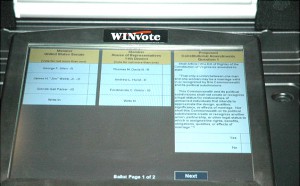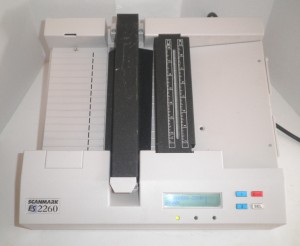
Advanced Voting Solutions (AVS)
AVS WINVote (and WINScan)
Make / Model: AVS WINVote (and WINScan)
Equipment Type: Direct Recording Electronic (DRE)
Summary

The Advanced Voting Solutions (AVS) WINVote is a Direct Recording Electronic voting system with a touch-screen voting terminal equipped with a wireless local area network (LAN), a 15-inch full color screen with zoom capabilities, and built-in battery backup power, modem, and printer. When operational in a live election environment, the WINvote terminal rests in a plastic voting booth/secrecy and transportation case. It is designed as a stand-alone system to function both as a traditional precinct voting device and as a non-geographic voting station.
AVS WINVoteWINware is the election management software for the WINvote systems. WINprep is a software application designed to enable county election officials to perform all aspects of the election programming process.
WINresults is a comprehensive tabulation, accumulation and reporting system. The method of manual data transfer requires poll workers to transport the WINvote ballot station to the central tabulation facility or, if election procedures permit, the USB drive may be removed from the ballot station and transported via vehicle to the county central tabulation facility. During that process, however, other data including hardware, diagnostic test logs, ballot images, ballot cast logs, operational audit logs, ballot images, ballot cast logs, operational audit logs and use activity from the polling location are collected and stored in single USB type memory devices for archive and audit use. AVS uses 802.11b wireless technology in their voting system to open every voting machine to program ballots, this system “beams” the ballot via wireless networking.
As of 2016, the AVS WINVote and WINScan are no longer used in U.S. elections.
Voting Process


After checking in at the polling place, the voter will approach one of the terminals. An election official will activate the machine. The voter will touch the “Click Here to Start” button on the welcome screen, and the ballot-marking process will begin. The screen can be programmed to display one race at a time, with available choices listed below the race name, but most often multiple races will be displayed on the screen. Write-in candidates can be selected by touching the “Write-In” button at the bottom of the choice list. After making a selection, touch the “Next” button on the bottom of the screen.
When all selections have been made, the voter will be taken to a summary screen that lists that name of each race and the option that was selected by the voter. If the voter wishes to change any of these races, he/she should simply touch the name of the race and make another selection. When the voter is satisfied with the summary screen, he/she should touch the red “Next” button on the bottom-right part of the screen. The next screen has a large red “VOTE” button. After touching that button, the ballot has been cast.
WINScan: As part of their voting system suite, AVS offered the WINscan System for the tabulation of absentee ballots. WINScan Ballots are programmed from WINware, the same single-entry application software set that creates electronic ballots for the WINVote DRE. These ballots were then scanned by commercial off the shelf optical scanners produced by Scantron, Inc. Three Scantron models were sold by AVS as part of this system: Model 2260 (left) or 2800 and the larger Model 6500 which has multiple outstacking capabilities.
Resources
Virginia Voting Machines Have ‘Vulnerability’ to Wireless Sabotage, CIO Journal (Sept. 28, 2012)
Advanced Voting Solutions WINware Voting System v.2.0.4 Test Plan Rev.2.0, EAC (2007)
Advanced Voting Solutions WINvote Re-examination, Pennsylvania Secretary of the Commonwealth (2007)
Security Concerns
Memory Card Is Sensitive
Corrupt memory cards can introduce viruses, cause the main election server to crash and falsify votes. Access to the MBB memory card should be controlled, monitored and logged at all times.
Wireless Vulnerabilities
The WINVote can be used in a wireless mode that involves individual machines talking to to other machines in each precinct. Wireless transmission of voter authentication and vote data can be very problematic and prone to error and malicious intervention. Moreover, there is evidence that the WINVote system operates over cellular frequencies (CDPD) as well as wireless data frequencies (802.11b) which considerably widens the possibilities of remote tampering.
Security Seals
Ideally, the WINVote’s exposed ports, memory card access areas and case seams would be covered with tamper-evident security seals. The integrity of these seals should be maintained at all times, and only breached under controlled, explained circumstances. Seals should be logged to maintain chain of custody of sensitive materials.
Manufacturer Profile
Founded in 1905 by Samuel R. Shoup as Shoup Voting Machines Company, re-organized in the 1950s as R.F. Shoup Corporation, re-organized again as Shoup Voting Solutions, Inc. in 1992, and renamed Advanced Voting Solutions in 2001. In 2007, after failing to gain EAC certification to the 2002 Voting System Standards, AVS discontinued production of voting systems.
